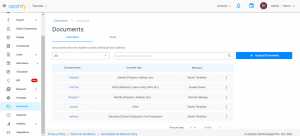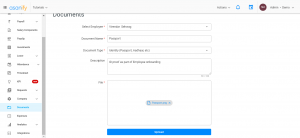New employee onboarding is one of most important factors of an employee’s success. None of the previous rule books apply because remote work has changed the game. Today I provide easy to implement yet complete onboarding process checklist for the future. A good onboarding process sets the tone and foundation for the employee’s time in the company. When you onboard an employee well, you not only showcase utmost professionalism but also boost employee engagement and retention.
In this blog, I have written a detailed guide to employee onboarding, covering the following topics,
- What is employee onboarding?
- Why is an efficient employee onboarding process important?
- Orientation vs Onboarding- what’s the difference?
- What should you include in the employee onboarding process (before the first day)?
- Employee onboarding tasks that you should do on the employee’s first day
- Employee onboarding activities that continue after the employee’s first day
- Why should you keep checking and modifying your employee onboarding process?
- What are the benefits of automating your employee onboarding process?
- How can you make virtual onboarding effective and fun?
- Conclusion
- FAQs
What is employee onboarding?
Employee onboarding is a process that begins right from the acceptance of the offer letter. It goes on right up until they complete around 6 months with an organization. Yes, many people assume that the onboarding process ends once a new hire starts working, but the first few months are crucial as well.
Onboarding includes everything right from introducing your company to the new hire, providing them with all the tools required to do their job and also making them feel like an important part of the team. It helps new employees adjust to the professional as well as social norms of the company.
The onboarding process has become even more daunting and important now, work from home on the rise. Read on to understand how you can carry out a complete and efficient onboarding process well.
Click here to download your employee onboarding checklist for FREE!
Why is an efficient onboarding process important?
Did you know that 69% of employees are more likely to stick with their job for 3 years if they experience a great onboarding? The job market has become extremely employee-centric. With the high demand for well trained, experienced candidates, recruiting is probably the most important HR sub-function. But second to that is employee onboarding. Here’s why it is so important
Employee onboarding keeps candidates engaged thus reducing turnover
Any candidate you select will probably be looking at other companies as well. So how do prove to the candidate that your company is a better place to work? When you keep in touch with a new hire right from the get-go, you make them feel important. It also keeps them engaged with your company. In other words, you are building and maintaining a good rapport with the new hire.
Helps employees prepare themselves for the job
When you provide your newly hired candidate with all the correct information and details about the industry and the job on time, it allows them to go through it thoroughly before the joining date. As a result, they will be aware of the work and how to do it. This saves you the time and energy of having to go through it with them again. Also, when you act professionally right from the beginning, you inspire the candidate to also be up to date with their work. Thus, increasing the likeliness of them taking initiative and working well from the start.
Creates a strong foundation for the candidate’s future with the company
Through the onboarding process, you can establish your company’s vision, mission and goals. It is also the best time to showcase your company culture to your new employees. Whether it is a sales employee’s onboarding or a software engineer’s, it is extremely important. When an employee feels important from the very beginning, they are more likely to reciprocate that importance in the way they work for you.
Ensure work compliance from the very beginning
When you have a well-planned onboarding process, the new employee knows exactly what is expected of them. You set standards right from the beginning. So as a result work gets done, and it gets done well from the beginning.
Onboarding vs orientation: What’s the difference?
A lot of HR employees and founders confuse onboarding with an orientation program. But they aren’t synonyms and absolutely cannot be used interchangeably. So let’s start with orientation.
What is orientation?
An orientation program is defined as a program that gives the employee an overview of the company’s vision and mission. It helps the employee understand how things are done in this company, the company culture etc. An orientation is quite limited in its scope and does really go beyond the sharing of knowledge.
What’s the difference between employee onboarding and orientation?
The major difference is that an orientation program is a part of the onboarding process. Orientation is a short series of sessions or workshops whereas onboarding is almost a 6-month if not year-long process. It is important to keep this distinction in mind while planning an onboarding process.
Click here to download your employee onboarding checklist for FREE!
What should you include in an employee onboarding process: before the joining date
There are many things that need to be done as a part of an onboarding process. I have segregated them based on,
- Before the joining date
- On the new employee’s first day
- After the first day
This will help you understand the timeline of events better. So let’s get straight to the tasks to be completed before the first day (joining day).
Send a formal offer letter
As soon as a candidate verbally accepts the job, you should send them a formal offer letter to sign. Sending a written job offer letter allows you to confirm all the minute details that were discussed before. Right from salary details, working days to job description etc, these details become a part of a contract signed by both the employer and employee.
The offer letter works as a contract between the employer and employee serving as a reference for all future negotiations.
Send a welcome email
This step may not feel like such a big deal, but it goes a long way in making the new employee feel welcome and important. It does even have to be very elaborate. Just something as simple as ‘congratulations’ and ‘we’re happy to have you on board’ will do the trick.
Get all the KYC documentation out of the way
When you hire a new employee, you need to get all the documentation in place. As of 2018, the government of India has made it mandatory for every individual to link their PF account with 3 documents namely
- Document showing date of birth, like birth certificate
- Work experience certificates
- Education/Academic background certificates
- Adhaar card details
- PAN details
- PF (Provident Fund) details
- Medical certificates
- Bank account details
Generally, this can be done either by the employer or employee (on behalf of the employee). But both employer and employee need for it to be done for their own accounts. Also, it’s better to get all this done before the first day. When an employee enters the workplace (or joins a zoom or google meet call for that matter), you don’t want their excitement and nervousness getting overrun with paperwork.
The HR usually could find it really complicated to do all of this via email. Especially when you need to dig up documents later on for audit purposes. A better way is to use google drive, or even better is an HRMS such as Asanify to keep track of all these documents.

Each employee can store the documents on her own and the employer or HR can view every employees’ documents. Hence simplifying the entire process. Like in the images shown here!

Notify the current employees
Your current employees need to know if someone new is joining your team. This is because they will be able to welcome the new employee well rather than not know who the new employee is at all. Maybe you could get some of the older employees to write a personalized welcome message to the new employee.
A new employee brings in a new perspective and a new sense of motivation to a group. There could be a change in dynamics in the team as a result of that. Hence, if the older employees know about the new arrival, this won’t have a negative effect.
Share industry and company details in advance
When you keep sending the new employee updates about the company or industry, it makes them feel like a part of the team even before their first day. It also helps them prepare for the job better.
Assign a buddy or mentor
When a new employee is joining a company of more than 25 or 30 people, it’s easy to get lost in the crowd. Assigning a mentor will give the employee a person they can go to for anything and everything they need. Ideally, a buddy or a mentor should be someone who has been with the company for at least a year and should hold a slightly senior position as compared to the new employee.
Provide access to company accounts
If the new employee has a role that requires them to access company social media pages or any other accounts, it is better to give them access a couple of days before their job begins. This is so that on the first day, you aren’t running up and down between the IT team or Head of departments trying to get access and let the new employee start work.
Add employee to the company payroll list
With the help of a payroll software, you will easily be able to add a new employee to the list. Simply add the new employee’s name, personal details (which anyway a part of the onboarding process), salary structure, applicable policies and you’re done. It’s really that simple. We at Asanify offer a payroll that will really simplify your work.
Research the different policies, taxes and compliances applicable
There are various policies that come into play as your hire more employees, I have stated them below
- ESI, meaning Employee State Insurance is applicable to companies across India having at least 10 employees
- EPF i.e. the Employee Provident Fund scheme is run by the EPFO and is generally applicable o companies with a minimum of 20 employees. However, in some scenarios, even startups with fewer employees can apply for the same. Also, read up about the latest changes made by the EPFO to their EDLI scheme.
- Professional tax (PT) deduction has to be done by the employer in the case of employees who earn salaries.
- HRA, that is House Rent Allowance. Any employee who has HRA as a part of the salary structure lives on rent and has rental receipts can claim tax deductions. Read our blog on HRA to see how this affects you or your new employee.
- TDS is a form of tax implemented to curb tax evasion. Income tax is deducted right from the source as opposed to a later date. This is something you as an employer need to be completely aware of. Read up about ‘Tax deducted at source (TDS)‘ to know more.
Deal with the logistics before day 1
If I was writing this blog before Covid-19 I would have mentioned things like parking space, working space in the office etc. But now, with the current work from home culture, these things become redundant. Instead, remember to check in with the employee about their internet connection, the kind of equipment they have (laptop, mobile etc.) or something link sending them the zoom or google meet links to an important meeting that will happen on the first day well in advance. With all of this, we have reached the end of the list of things you need to do before the employees joining date. But there’s plenty that still has to be done. Read on to know about the employee onboarding tasks as a part of the employees first day at your company.
Employee onboarding tasks to be done on the employee’s joining day
So, what are the things that have to be done on the employee’s first day?
Give the new hire a welcome kit
A welcome kit doesn’t have to be very elaborate. This could be done before, but when you do it on the first day, it really surprises the new hire. Add a little company swag in the welcome kit as well. But I think the most important is, a personalized welcome note, either from a peer, buddy, mentor or immediate supervisor. This creates a warm feeling for the employee, letting them feel happy and welcome.
Plan an orientation program for day 1 as part of the employee onboarding
Earlier we spoke about how an orientation program is different from onboarding. So plan an orientation program accordingly. You could also add a session or workshop specifically focusing on company culture and soft skills for the job. This could also include a short, one-day training program.
Gradually introduce the employee to their first week or month
It is important to be crystal clear here. Inform the employee about the day to day tasks expected of them and who they need to report to. Needless to say, you shouldn’t bombard the new hire with excess information and details. Make them a productive member of the team in a gradual and steady manner. This is also where you inform the employees about the KPIs that will be used to monitor them so they know they are accountable at every step of the way.
Roadmap the employee’s first 3 months as a part of employee onboarding
Sit with the employee and form a rough plan of what has to e done by the employee throughout their first 3 months of working with a company. Formulate a 3-month plan for the employee so that they aren’t lost and know exactly what is expected of them. Visit our blog on the 30 60 90 day plan for an HR employee for reference.
Create a schedule for regular check-ins, catchups and feedback sessions
Feedback is crucial for any new employee. For a new hire to feel productive in any team, they need to know that they are doing the job correctly. You can make sure they’re on the right track by organizing regular feedback sessions. Also, organize regular check-ins or catchups sessions as well. They aren’t really to provide feedback to the employee about their work. This is a way to ensure that the employee doesn’t feel out of place in their team or even in the company at large. It is also to ensure that you are able to provide the employee with an environment that will help them be proactive and perform to the best of their ability.
Employee onboarding tasks that continue after the first day
Very often people assume that onboarding ends once the employee’s first day is over. But that isn’t true at all. Yes, while most of the employee onboarding tasks are over by this point, you still have a couple more things to do. These can either continue throughout the first 90 days or even for 6-8 months of employment. These tasks are,
Encourage and celebrate early wins
Early wins for any employee are a huge deal. How HR or even management reacts to these early wins is also a huge deal. It hence becomes very important to ensure that you celebrate such successes. It doesn’t have to be a huge celebration like a party or anything. But something as simple as announcing and recognizing the good work of the employee in front of their team or department etc. This doesn’t really have to be restricted to new employees either. You could have a monthly announcement or bulletin which focuses on star employees. This will really help boost your employer reputation.
Plan regular team-building or employee bonding activities
Team bonding isn’t something that happens overnight. Yes, working on the same team can really make employees build trust. But bonding activities are kind of useless if they happen once a year or only on orientation day. Make sure you allow team members to blow off some steam at least on a monthly basis, without having to talk about work.
Why should you keep modifying your employee onboarding process?
Change is the only constant we have. Sounds way too cliche right? But it’s also true. You need to speak to employees who have been with you for around a year or two. Ask them how they think the new hiring and onboarding process can be improved. There’s a very good chance you think you’ve got the best onboarding process possible, but in reality, it only makes the new hires awkward or nervous. If you keep modifying your employee onboarding process after speaking to people who have been through the process, you will be making changes for the better. Also, don’t change something just because you heard something negative from a single employee. Focus on who is giving the feedback and how many people agree with it. So, focus on meeting senior managers, supervisors and your HR team at least once or twice a year so take a look at your onboarding process and how it can be improved.
What are the benefits of automating employee onboarding?
There has been a drastic increase in the use of artificial intelligence in HR. An HRMS can reduce the stress of manually doing everything alone while automating and streamlining processes. Here are some of the reasons why automating your employee onboarding process will help you drastically.
Increase efficiency which will increase employee retention
When you automate your onboarding process, you create an extremely good impression on the candidate. As a result, you also come across as very professional. While the entire process becomes very efficient it also results in increased retention. This is because good onboarding can contribute to building teams that thrive together. When your employees look forward to working with each other, they are less likely to want to leave. Hence, the turnover rate falls drastically.
Streamline the documentation process while employee onboarding
When you use an HR software, you also won’t miss out on any step in the process. The software will keep track of and remind you of the tasks that are left to be done. Hence the onboarding process remains the same for all employees and will only differ if you make changes. In the same way, you also won’t make any mistakes in the entire documentation process, because you will be able to save all documents on the software itself. This will all be done in a systematic way, making it easier for future reference as well.
Click here to download your employee onboarding checklist for FREE!
How to make virtual onboarding effective and fun?
We have seen all the steps that form an onboarding process. But the real challenge today that a lot of HR employees are facing is virtual onboarding. So, I have put together some tips to keep in mind so as to make an online onboarding process effective. This is obviously apart from the regular onboarding steps and tasks.
- Use software to onboard your employee and carry out the documentation process. This way there won’t be any delays with employees sending this by post or even confusion with emails for that matter.
- Send the employees an organizational chart so that they know who is who well in advance
- Organize regular calls between the new hire and their buddy or mentor
- Find a good balance between training, work, orientations, workshops etc.
- Organize employee trivia-based spot quizzes etc. for the first day
- Organize online games with the new employees. There are many online ice breaker games you can use.
- Ensure that your new employees are working with multiple people because it is easy for fatigue to set if they speak to only 1 or 2 people day in and day out.
- Organize a virtual lunch (obviously, everyone gets their own food). But maybe your company could sponsor one meal and get the employees together for that one meal, encouraging bonding.
Conclusions
Having a well-planned onboarding process is so important. Whether you’re an HR head or a founder trying to provide your employees with the best experiences possible, onboarding plays a huge role. As you have seen, formulating a good employee onboarding plan for your new employees is never going to be easy. But if you simply follow the steps mentioned above you will be able to provide an all-inclusive onboarding process for all your new employees. Thus, you will be able to boost your employer brand as well.
FAQs
In short, no, training and onboarding are not the same. An employee can be a part of a training program or session during any part of their employee lifecycle. On the other hand, onboarding can only be done when an employee joins a new company. Also, onboarding focuses on making sure an employee is well equipped to start their new job, both in terms of information and skills.
To have a successful onboarding process, make a thorough plan that includes all the onboarding steps and tasks. Make sure you keep seeking feedback for your onboarding process and modifying it and improving it as needed.
A good onboarding process can be as short as 3 months to as long as a year. It depends majorly on how well planned it and how prepared your new employees are to do their new job.
YES! You do have to pay employees for time spent in the onboarding and orientation process. Anything related to the company that the candidate spends time on, especially after the joining date should be paid.
Not to be considered as tax, legal, financial or HR advice. Regulations change over time so please consult a lawyer, accountant or Labour Law expert for specific guidance.
![You are currently viewing Easy Virtual Employee Onboarding Guide: Process and Checklist [2021]](https://media.asanify.com/wp-content/uploads/2021/05/07121316/linkedin-sales-solutions-Be5aVKFv9ho-unsplash-scaled.jpg)




